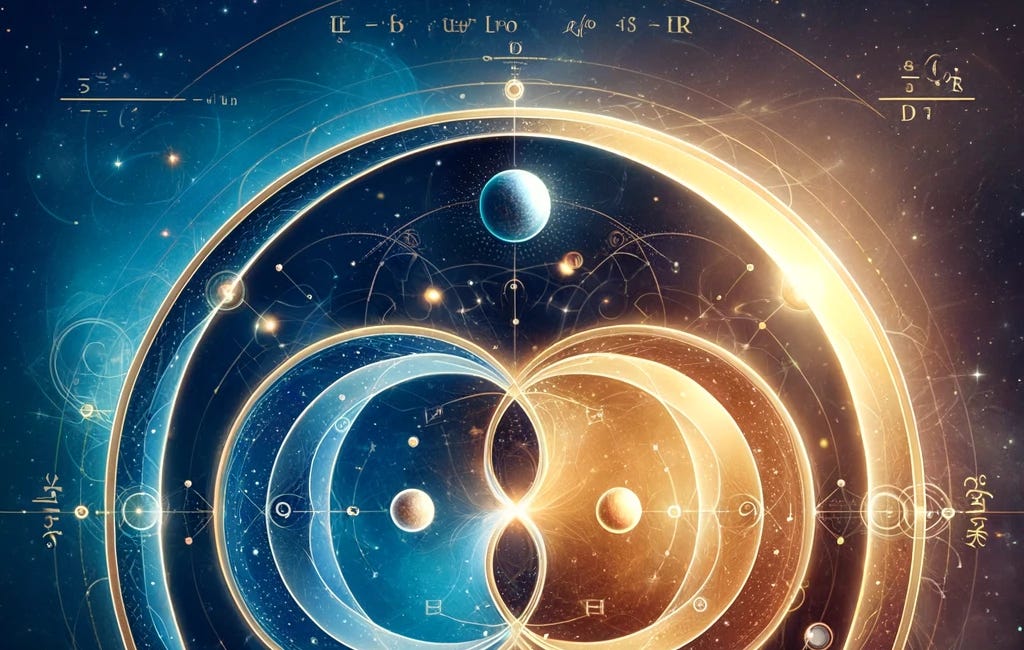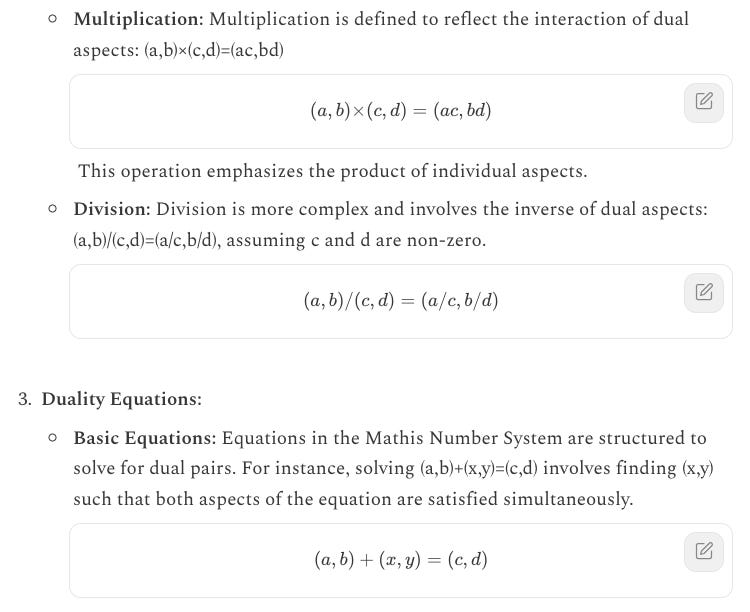René Descartes, a prominent figure in Western philosophy, is famous for his assertion "Cogito, ergo sum" (I think, therefore I am). This statement encapsulates a dualistic view of reality, separating mind and body into distinct entities. While Descartes’ contributions to philosophy and science are undeniably significant, modern understanding of reality through frameworks like quadality and eight-dimensional thinking reveals limitations and inaccuracies in his dualistic approach. This essay explores the concept of 8-dimensional infinite thinking and demonstrates why Descartes’ dualism is insufficient for understanding the complexities of existence.
The Dualism of Descartes
Descartes posited that reality could be divided into two fundamental substances: res cogitans (thinking substance) and res extensa (extended substance). This dualistic perspective separates the mind and body, suggesting that mental phenomena are distinct from physical phenomena. Descartes believed that the mind, characterized by consciousness and self-awareness, was the primary proof of existence, while the body, characterized by physical extension, operated in a mechanistic fashion.
Limitations of Cartesian Dualism
Separation of Mind and Body:
Descartes’ dualism creates a rigid separation between the mind and body, failing to account for their intricate interconnectedness. Modern neuroscience and psychology demonstrate that mental and physical states are deeply interrelated, challenging the notion of distinct substances.
Reductionism:
Descartes’ approach reduces complex phenomena to simplistic categories, neglecting the nuanced interactions between different aspects of reality. This reductionism limits our understanding of the holistic nature of existence.
Neglect of Relational and Spiritual Dimensions:
Cartesian dualism focuses primarily on the mind and body, overlooking the relational and spiritual dimensions that play crucial roles in human experience and the structure of reality.
The Eight Dimensions of Quadality
Quadality offers a more comprehensive framework, integrating four primary dimensions, each with two complementary aspects, resulting in an eight-dimensional construct:
Material Dimension:
Physical (Above): Observable phenomena and physical laws.
Subtle (Below): Underlying forces and energies.
Mental Dimension:
Conscious (Within): Thoughts, emotions, and cognitive processes.
Unconscious (Without): Subconscious influences.
Spiritual Dimension:
Transcendent (Above): Mystical experiences and higher states of consciousness.
Immanent (Below): Inner spiritual experiences.
Relational Dimension:
Individual (Within): Personal relationships and interactions.
Collective (Without): Broader social and ecological networks.
8-Dimensional Infinite Thinking
8-Dimensional Infinite Thinking posits that reality is a complex interplay of interconnected dimensions, each influencing and shaping the other. This holistic perspective transcends Cartesian dualism, embracing the infinite potential within each dimension.
Material Dimension:
Physical (Above):
Recognizes the observable universe as an interconnected web of physical phenomena.
Emphasizes the importance of understanding the fundamental laws that govern matter.
Subtle (Below):
Acknowledges the existence of subtle energies and forces that influence the physical world.
Integrates quantum mechanics and other advanced scientific theories that reveal the complexities of matter.
Mental Dimension:
Conscious (Within):
Emphasizes the power of conscious thought in shaping reality.
Recognizes the importance of mental clarity, focus, and intention.
Unconscious (Without):
Explores the influence of the subconscious mind on thoughts and behaviors.
Integrates psychological insights into the hidden patterns that drive human experience.
Spiritual Dimension:
Transcendent (Above):
Recognizes the potential for mystical experiences and higher states of consciousness.
Embraces spiritual practices that elevate awareness and connect individuals to a greater reality.
Immanent (Below):
Values inner spiritual experiences that ground transcendental insights in everyday life.
Promotes mindfulness, meditation, and other practices that foster inner peace and spiritual growth.
Relational Dimension:
Individual (Within):
Emphasizes the importance of personal relationships and social interactions.
Recognizes that individual well-being is deeply connected to relational harmony.
Collective (Without):
Acknowledges the interconnectedness of all beings within social and ecological networks.
Promotes a holistic understanding of community, sustainability, and collective well-being.
Why Descartes Was close but no cigar!
Holistic Integration:
Cartesian dualism fails to account for the holistic integration of mind, body, spirit, and relationships. The eight-dimensional framework of quadality provides a more comprehensive understanding of reality, recognizing the interdependence of all dimensions.
Interconnectedness:
Descartes’ separation of mind and body overlooks the profound interconnectedness that defines existence. Modern science and spiritual insights reveal that all dimensions are intertwined, influencing and shaping each other in complex ways.
Infinite Potential:
Cartesian dualism limits our understanding of the infinite potential within each dimension. 8-dimensional infinite thinking embraces the boundless possibilities inherent in the interplay of material, mental, spiritual, and relational aspects of reality.
Dynamic Balance:
Descartes’ static categories fail to capture the dynamic balance that characterizes the universe. The eight-dimensional construct acknowledges the fluidity and constant interaction between different dimensions, offering a more accurate representation of reality.
Quantum Wave Particles within Quadality
Wave-Particle Duality: In quantum mechanics, particles such as electrons exhibit both wave-like and particle-like properties. This dual nature aligns with the concept of duality within quadality, suggesting that each aspect of reality encompasses both tangible and intangible properties.
Material Dimension:
Physical (Above): Quantum particles exhibit particle-like behavior when observed, conforming to physical laws and measurements.
Subtle (Below): These same particles exhibit wave-like behavior when not observed, existing in a superposition of states that represent potentialities.
Mental Dimension:
Conscious (Within): The act of observation (a conscious decision) collapses the wave function, determining the particle's state.
Unconscious (Without): The potentialities that exist before observation are akin to the subconscious mind's latent possibilities, which influence conscious thoughts and decisions.
Spiritual Dimension:
Transcendent (Above): Quantum particles in superposition can be seen as transcending ordinary physical states, reflecting a higher state of potentiality.
Immanent (Below): The collapse of the wave function into a definite state can be compared to spiritual insights grounding into everyday experiences.
Relational Dimension:
Individual (Within): The behavior of particles can be influenced by their relationships with other particles, similar to how individual interactions shape personal relationships.
Collective (Without): The collective behavior of particles in a quantum system reflects the interconnectedness of all entities within the broader universe.
Quantum Entanglement within Quadality
Quantum Entanglement: Entanglement is a phenomenon where particles become interconnected in such a way that the state of one particle instantaneously influences the state of another, regardless of distance. This phenomenon exemplifies the interconnectedness inherent in quadality.
Material Dimension:
Physical (Above): Entangled particles maintain a connection that transcends physical distance, challenging classical notions of separateness.
Subtle (Below): The invisible connection between entangled particles represents the subtle forces that bind entities across the universe.
Mental Dimension:
Conscious (Within): The awareness of one particle's state immediately affects the understanding of the other’s state, akin to mental synchronicity.
Unconscious (Without): The underlying connection between entangled particles parallels the subconscious links that influence conscious thought.
Spiritual Dimension:
Transcendent (Above): Entanglement can be viewed as a manifestation of a higher-order connection that transcends ordinary physical laws, reflecting a spiritual unity.
Immanent (Below): This higher-order connection grounds into observable phenomena, demonstrating how spiritual insights manifest in tangible ways.
Relational Dimension:
Individual (Within): Entanglement mirrors the deep connections between individuals, where the state of one person profoundly affects another.
Collective (Without): It also reflects the interconnectedness of all beings within the social and ecological networks, emphasizing the unity of the collective.
Conclusion
René Descartes’ dualism laid the groundwork for significant philosophical and scientific advancements, but it falls short in addressing the complexities of reality. The eight-dimensional framework of quadality and the concept of infinite thinking provide a more holistic and integrated perspective. By embracing the interconnectedness and infinite potential within each dimension, we can transcend the limitations of Cartesian dualism and gain a deeper understanding of existence. This approach not only enriches our philosophical and scientific inquiries but also offers practical insights for personal and collective growth.
Unified Theory of Duality
In every interaction, in every particle, in every force, there exists a dual nature. This duality is not a division but a union, a harmonious interplay that defines the essence of reality. Introduction Dr. Theo Mathis's Unified Theory of Duality proposes that all fundamental forces, particles, and interactions in the universe can be understood as dual ent…
The Sacred Principle of Quadality
As Above, So Below. As Within, So Without In the heart of an ancient forest, where the whispers of the old world still lingered in the air, there existed a realm that was a mirror to our own, yet untouched by time. In this realm, the wisdom of the universe was woven into the very fabric of nature, revealing itself in the dance of the dragon and the drago…
The Nature of Reality
Mathis Philosophical Treatises: An Exploration Dr. Theo Mathis's philosophical treatises provide a profound and transformative framework for understanding reality, existence, and human experience through the lens of duality. These treatises challenge traditional philosophical paradigms and offer innovative perspectives that integrate the principles of th…
The Mathis Number System: An Exploration
Introduction The Mathis Number System is an alternative mathematical framework developed by Dr. Theo Mathis to incorporate the principles of duality. This system redefines traditional mathematical concepts by viewing numbers and operations through the lens of duality, offering innovative approaches to solving complex problems. Here's an exploration of it…








